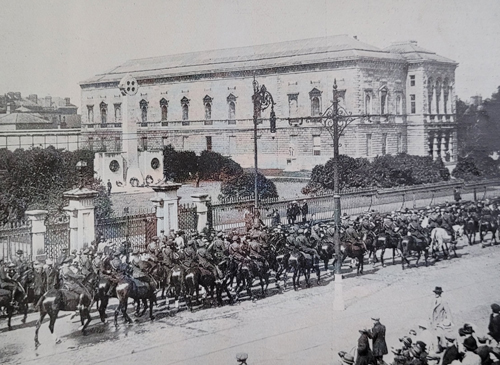Memorial unveiled to dead leaders described as “the architect and the master-builder of our nation”
Dublin, 14 August 1923 - A new memorial to two ‘dead leaders’ - President Arthur Griffith and General Michael Collins - was unveiled in Leinster Lawn on Dublin’s Merrion Street yesterday.
They were, President Cosgrave said, the ‘architect and master builder of our nation.’ A ceremony to publicly reveal the temporary cenotaph to the men who ‘gave their lives in doing their duty to Ireland’ was held yesterday on the first anniversaries of their respective deaths and before an attendance of Ministers, members of the Dáil and Seanad, public bodies and a large military contingent.
In attendance, too, were members of the Griffith and Collins families. The young son and daughter of Arthur Griffith were present alongside their uncles, the Franciscans Father Leo and father Peter Sheehan. The brother and sisters of Mr. Michael Collins also attended and there was a poignant moment when Mr. Seán Collins, brother of Michael, stepped forward and, at the base of the cenotaph, shook hands with Nevin Griffith, the young son of the deceased president of Dáil Éireann.
The cenotaph was covered top to bottom in a white cloth before the ceremony and its unveiling was performed by President Cosgrave, whose arrival alongside the Governor General, signalled the commencement of the ceremony.
Designed by Mr. George Atkinson, RHA, and situated in a position of considerable prominence, the memorial is made of wood and covered with expanded metal lathing and cement. At its centre the monument features a Celtic Cross with simple pylons on either side of it, while at its front are medallion portraits of the dead leaders.
Pathé footage of Cenotaph to the memory of President Arthur Griffith and General Michael Collins unveiled in Dublin. Ireland,
Delivering an oration in advance of the unveiling, President Cosgrave said that the cenotaph was a ‘symbol of Ireland’s reverence and sorrow, of Ireland’s pride and gratitude, to the memory of two heroic men.’
He added:
‘A year ago, within the space of two weeks, came the awful tragedy of their death. They gave their lives in doing their duty to Ireland, and this was the death that they had always looked forward to and desired. They died before the fruit of their labours and perils could be tasted by them in this life, but many a patriot before them had gone bravely to death with less success in sight....The tragedy of the deaths of Arthur Griffith and Michael Collins lies in the blindness of the living who do not see, or refuse to see, the stupendous fact of the liberation these two men brought to pass.’
‘The men to whom we are here paying this homage of memory and gratitude were men with big hearts and generous souls. They would themselves resent it were this occasion to be used for bitterness or vilification towards those who have sought to blast the fruit of their endeavour. In truth, the crown of these two beloved lives will be the paramount rule of a united people in this land - united in individual obedience to the authority of the whole....’
Beneath a sun-kissed sky, President Cosgrave lauded the two lost leaders for their big hearts and generous souls and declared that their lives and example proclaimed the ‘lesson of work indefatigable, of tolerance wide and generous for disagreement in opinion, but intolerance most stern of attack upon the safety of the nation or upon the rule of the people.’
Once he finished, the monument was unveiled, the ‘Last Post’ sounded and a wreath was laid at the memorial’s base. The band outside the grounds of Leinster Lawn played Ingram’s ‘The Memory of the Dead’ to bring the programme of events to an end. Then, it was left to the large crowd to examine the monument up close for themselves, among them four old comrades of Michael Collins, who in military style, mounted a guard at each corner of the memorial where they lowered their heads over reversed rifles.
Earlier in the day, a memorial mass was celebrated at the Pro-Cathedral and in military barracks throughout the country, the occasion was marked by special parades of troops which were organised for the same hour as the ceremonies in Dublin.
[Editor's note: This is an article from Century Ireland, a fortnightly online newspaper, written from the perspective of a journalist 100 years ago, based on news reports of the time.]





















